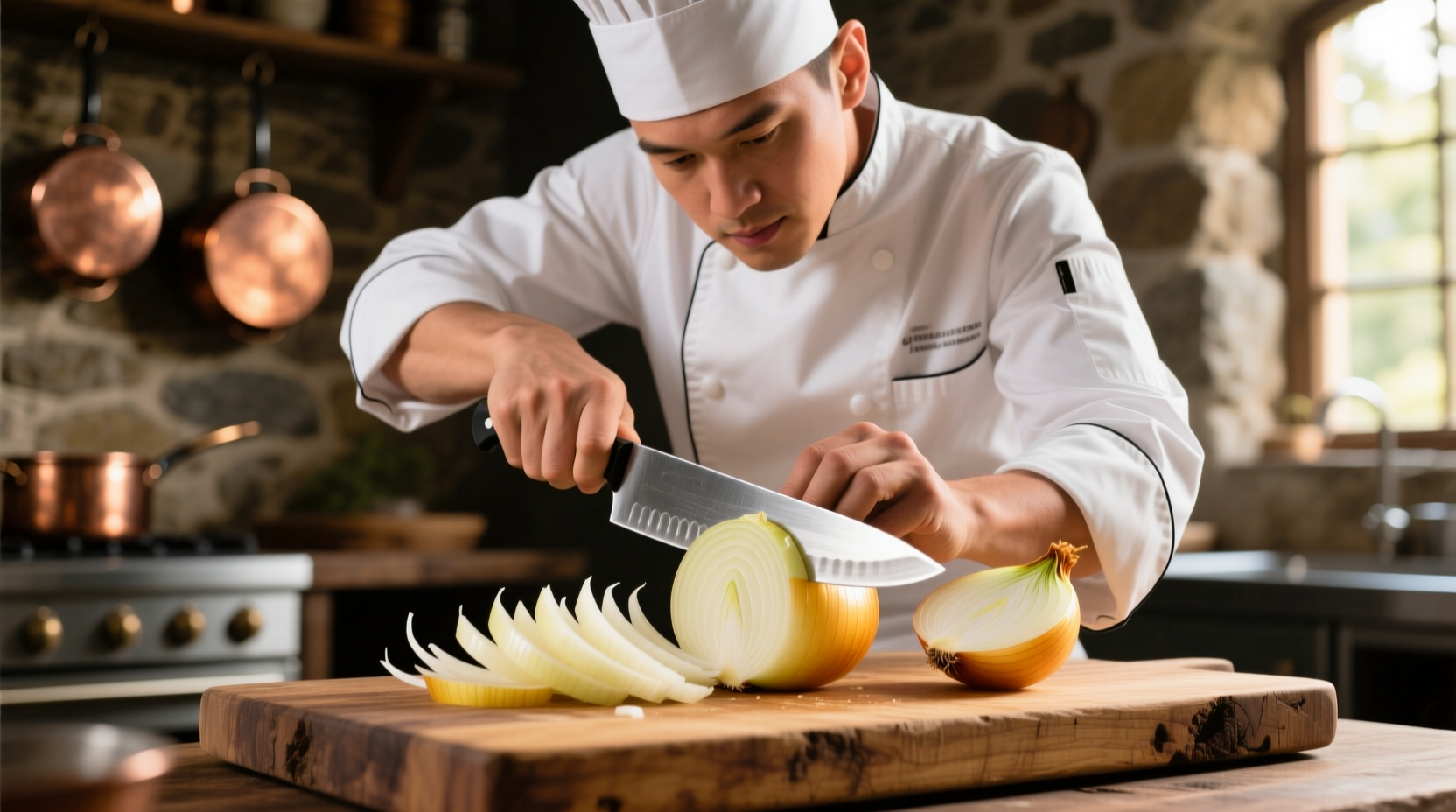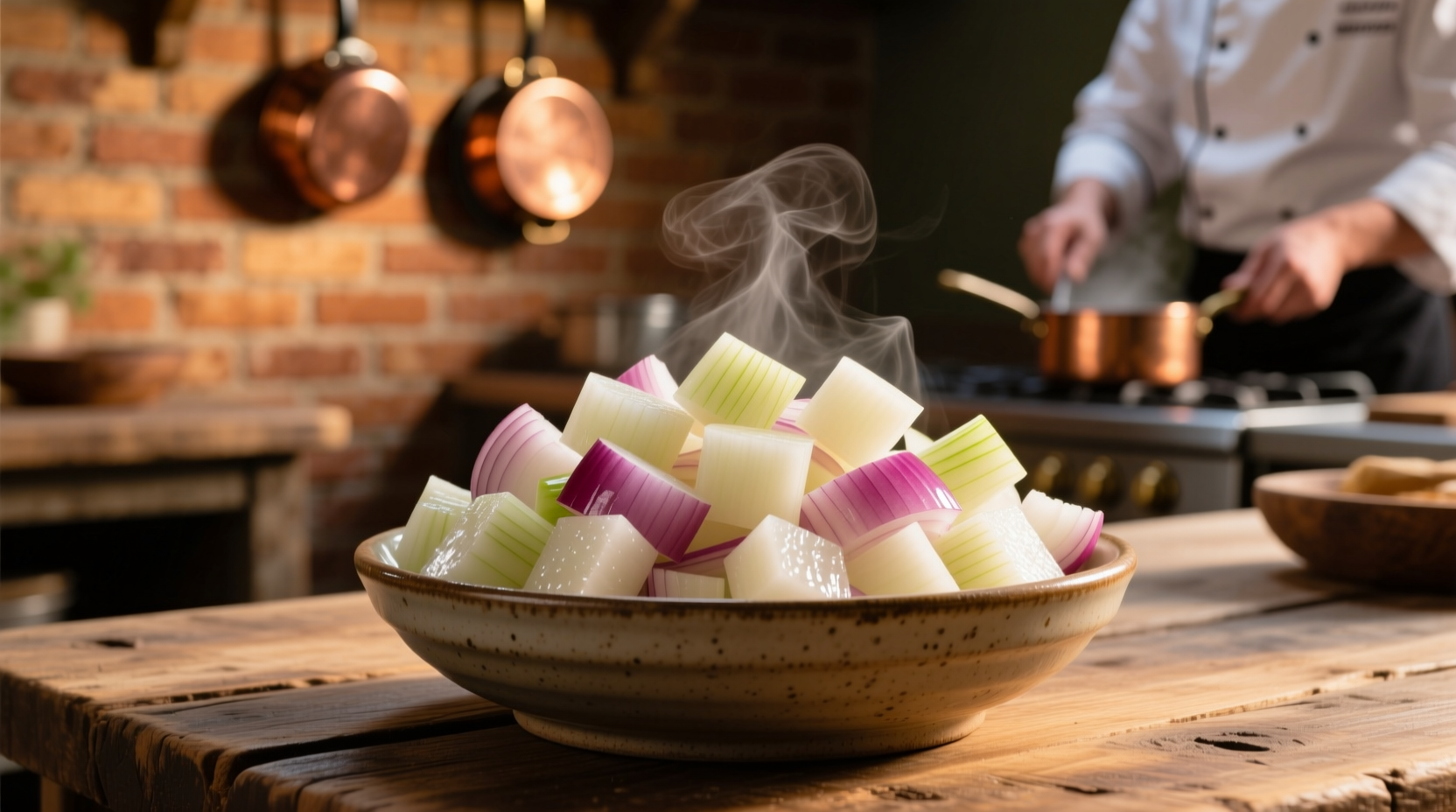Mastering the art of dicing onions transforms your cooking from haphazard to professional. This precise technique ensures consistent texture, optimal flavor release, and perfect integration with other ingredients. Whether you're preparing a classic mirepoix, crafting homemade salsa, or building flavor foundations for soups and stews, properly diced onions make the difference between amateur and expert results.
What Exactly Is Diced Onion?
When recipes specify "diced onion," they're calling for uniformly cut 1/4-inch cubes. This precise measurement creates consistent cooking behavior where each piece caramelizes and softens at the same rate. Unlike chopped onions (which vary in size) or minced onions (finely cut for quick flavor release), diced onions maintain their structural integrity while distributing flavor evenly throughout your dish.
| Preparation Type | Cube Size | Best Used For | Cooking Time |
|---|---|---|---|
| Diced | 1/4 inch | Stews, soups, salsas, mirepoix | 8-12 minutes |
| Chopped | 1/2 inch | Sauces, casseroles, stir-fries | 5-8 minutes |
| Minced | 1/8 inch | Dressings, meatloaf, quick sautés | 3-5 minutes |
Why Precision Matters in Onion Dicing
Professional chefs universally emphasize uniform dicing because inconsistent sizes lead to uneven cooking. Larger pieces remain undercooked while smaller ones burn, creating flavor imbalances. The USDA's Food Safety and Inspection Service confirms that uniform vegetable sizing promotes even heat distribution, critical for food safety in dishes requiring thorough cooking.
When onions cook unevenly, your entire dish suffers. Imagine making French onion soup where some pieces are caramelized perfection while others remain harsh and raw. Or picture a fresh pico de gallo where some onion chunks overpower the delicate tomato balance. Proper dicing prevents these culinary disasters.
Step-by-Step: Perfect Onion Dicing Technique
Follow these professional chef techniques for flawless diced onions every time:
- Select quality onions: Choose firm bulbs with dry, papery skins and no soft spots. Yellow onions work best for most savory applications due to their balanced sweetness and pungency.
- Prepare your workspace: Use a sharp 6-8 inch chef's knife and stable cutting board. Place a damp towel beneath your board to prevent slipping.
- Trim strategically: Cut 1/4 inch from both ends, then remove the outer skin. Never cut through the root end completely—leaving it intact maintains structural integrity during dicing.
- Create flat surfaces: Slice the onion in half vertically through the root. Place each half flat-side down for stability.
- Make vertical cuts: Holding the onion firmly, make vertical slices toward (but not through) the root end at 1/4-inch intervals.
- Crosshatch horizontally: Make horizontal cuts parallel to the cutting board at 1/4-inch intervals, again stopping short of the root.
- Final dice: Slice vertically downward at 1/4-inch intervals, releasing perfect cubes as you go.

Storage Solutions for Diced Onion
Proper storage extends the shelf life of your prepped onions while maintaining quality. According to FDA food safety guidelines, diced onions should be refrigerated within two hours of preparation:
- Refrigeration: Store in airtight container for up to 5 days. Place a damp paper towel on top to maintain moisture without sogginess.
- Freezing: Spread diced onions in single layer on baking sheet, freeze until solid, then transfer to freezer bags. Use within 6 months for best flavor.
- Vacuum sealing: Extends refrigerated shelf life to 10-14 days by reducing oxidation.
Never store diced onions in metal containers, which accelerate enzymatic browning. Glass or BPA-free plastic containers preserve flavor integrity best.
When Diced Onion Works Best (And When It Doesn't)
Understanding context boundaries prevents recipe failures. Diced onions excel in applications requiring:
- Recipes needing visible onion pieces (salsas, relishes, salads)
- Dishes with longer cooking times (stews, braises, soups)
- Recipes where texture matters (fajitas, stir-fries, grain pilafs)
Choose chopped or minced onions instead when:
- Creating smooth sauces or purees
- Preparing quick-cooking dishes (omelets, quick sautés)
- When maximum flavor infusion is needed without texture
Advanced Culinary Applications
Professional kitchens leverage diced onions in sophisticated ways home cooks can replicate:
Temperature-controlled cooking: Start diced onions in cold oil to draw out moisture slowly, creating deeper flavor development without burning. This technique, documented in the Culinary Institute of America's professional cooking manuals, produces superior caramelization.
Layered flavor building: Add half your diced onions at the beginning of cooking for foundational flavor, then stir in fresh diced onions during the last 5 minutes for bright, fresh notes—a technique used in traditional French cuisine.
Acid balancing: Toss diced onions with 1 teaspoon vinegar per cup before adding to salads. This preserves texture and balances sharpness, a method perfected by chefs in Mexican cuisine for optimal pico de gallo.
Troubleshooting Common Dicing Challenges
Even experienced cooks face these issues. Here's how to solve them:
- Excessive tearing: Chill onions for 30 minutes before cutting. The cold temperature reduces volatile compound release. Alternatively, cut under running water or near a lit candle.
- Inconsistent sizing: Use a guide stick (a small wooden dowel) alongside your knife to maintain uniform thickness.
- Browning too quickly: Reduce heat and add a pinch of sugar to promote even caramelization without burning.
- Strong aftertaste: Rinse diced onions in cold water to remove excess sulfur compounds, then pat dry before use.
Historical Context of Onion Preparation
Onion dicing techniques evolved alongside culinary traditions:
- 15th century: French chefs developed the mirepoix (diced onions, carrots, celery) as flavor foundation
- 18th century: Standardized dicing emerged with Escoffier's culinary codification
- 20th century: Food processors introduced inconsistent chopping, reviving appreciation for hand-diced precision
- 21st century: Molecular gastronomy explores enzymatic reactions in diced onions for flavor enhancement
This historical progression, documented by the Oxford Symposium on Food and Cookery, shows how precise dicing remains fundamental despite technological advances.
Expert Tips for Flavor Maximization
Professional chefs employ these advanced techniques:
- Timing is everything: Add diced onions to hot oil (not cold) for searing applications, but cold oil for slow caramelization
- Salt strategically: Sprinkle salt immediately after dicing to draw out moisture and accelerate cooking
- Layer aromatics: Combine with diced celery and carrots in 2:1:1 ratio for perfect flavor base
- Seasonal adjustments: Use sweeter Vidalia onions in spring/summer, sharper storage onions in fall/winter











 浙公网安备
33010002000092号
浙公网安备
33010002000092号 浙B2-20120091-4
浙B2-20120091-4